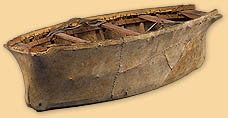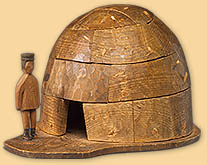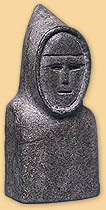 |
The annual report of the Geological Survey of Canada from 1914 relates:
"Toward the last of May E. W. Hawkes left for field work among
the Eskimo of Labrador. While the northern coasts were blocked with
ice, a thorough exploration of Hamilton inlet and Sandwhich bay was
undertaken to ascertain definitely the present southern limit of
Eskimo culture and considerable ethnological material was obtained.
Later the east coast was carefully surveyed to Cape Chidley, and further
ethnological specimens obtained. [...] On August 2, Mr. Hawkes joined
the Carnegie Magnetic expedition from Washington, D.C. and was then
able to extend operations to Hudson strait and bay. Both sides of the
strait and bay were visited, including the little-known east coast of
Hudson bay as far south as Cape Dufferin, Coats island and southern
Baffin island. Interesting specimens were obtained from this district
and Chesterfield inlet. As a result, the Museum has a complete
ethnological and archaeological Labrador Eskimo collection ...."*
While a fellow in anthropology at Columbia University, Hawkes was
hired by the Geological Survey to carry out this field trip in the
summer of 1914. He published a report on it in 1916.** He then returned
to the U.S. where he pursued an academic career. He is last mentioned
in the Who's Who in America in 1954.
*Summary Report of the Geological Survey - Department of Mines -
for the calendar year 1914. Ottawa: Taché, Printer to the
King's most excellent Majesty, 1915.
**E. W. Hawkes
1916 – The Labrador Eskimo. Ottawa: Government Printing
Bureau, (Geological Survey of Canada) Memoir 91; Anthropological
Series, No. 14.

 |
Umiak, 1914
Ungava Bay, Northern Labrador
Sealskin, sinew, wood
11.5 x 38.5 x 14.5 cm
CMC IV-B-317
Collected by Ernest William Hawkes during his field trip to
Labrador in 1914
|
 |
This beautiful model of an umiak may have been commissioned by
Hawkes, not as a souvenir item, but as ethnographic artifact.
Umiaks had largely been abandoned by the time Hawkes visited
Labrador.* As originals were not available, a replica, perfect in
all its details of construction, would have been the next best
thing.
*E. W. Hawkes
1916 – The Labrador Eskimo. Ottawa: Government Printing
Bureau, (Geological Survey of Canada) Memoir 91; Anthropological
Series, No. 14. p. 68.
Model of Igloo, 1914
Okak, Labrador
Wood, cotton
11.3 x 20.5 x 8.2 cm
CMC IV-B-330
Collected by Ernest William Hawkes during his field trip to Labrador
in 1914
|
 |
 |
"The Labrador Eskimo parallel nearly all their ivory work in
wood carving. As the missionaries will tell you, walrus ivory is
becoming scarce and the more plentiful material is used instead.
Woodwork of this sort includes komatiks and dogteams with their loads,
and even snowhouses, with the blocks and interior fittings carefully
imitated."*
*E. W. Hawkes
1916 – The Labrador Eskimo. Ottawa: Government Printing
Bureau, (Geological Survey of Canada) Memoir 91; Anthropological
Series, No. 14. p. 101.
Reference:
Martijn, Charles
1967 – "A Retrospective Glance at Canadian Eskimo Carving.
" Beaver Magazine. Autumn 1967, ill. p. 10.
Ivory Sled and Dog Team, 1914
East Coast Labrador
Ivory, leather, string, paint, paper
2 x 13 x 4.4 cm
CMC IV-B-321 a-h
Collected by Ernest William Hawkes during his field trip to Labrador
in 1914
|
 |
"A favorite design of the Labrador Eskimo is the Komatik and
dog-team which is carried out with great fidelity of detail, even to
the seals and snow-knife forming the Komatik load."*
*E. W. Hawkes
1916 – The Labrador Eskimo. Ottawa: Government Printing
Bureau, (Geological Survey of Canada) Memoir 91; Anthropological
Series, No. 14. p. 100, ill. plate XXV.
Exhibition History:
In the Shadow of the Sun: Perspectives on Contemporary Native Art.
Museum am Ostwall fuer Kunst und Kulturgeschichte, Dortmund,
Germany, December 9, 1988 – February 27, 1989; Canadian Museum of
Civilization, Hull, Quebec, June 29, 1989 – January 2, 1990; Art
Gallery of Nova Scotia, Halifax, Nova Scotia, April 20 – June 24,
1990; Rijksmuseum Voor Volkenkunde, Leiden, Netherlands, August 30 –
October 18, 1991. Exhibition catalogues in German and English.
References:
Hoffman, Gerhard (ed.)
1988 – Im Schatten der Sonne: Zeitgenoessische Kunst der
Indianer und Eskimos in Kanada. Exhibition catalogue. Stuttgart:
Edition Cantz, no. 132, ill. p. 443.
 |
Soapstone Figure of Man (fetish?), 1914
Ailik, near Hopedale, Labrador
Grey stone
11 x 5 x 4 cm
CMC IV-B-319
Collected by Ernest William Hawkes during his field trip to
Labrador in 1914
|
 |
"There appears to be among the Labrador Eskimo the idea that
not only the shaman, but every person, has his individual familiar
spirit whose assistance is sought in hunting and other ventures. This
is embodied in the material form of a doll or doll's head, which is
carried somewhere about the person, often around the neck. [...] I
procured two of these specimens, which were found by a trader concealed
in a bundle of skins which he had bought from an Eskimo."*
*E. W. Hawkes
1916 – The Labrador Eskimo. Ottawa: Government Printing
Bureau, (Geological Survey of Canada) Memoir 91; Anthropological
Series, No. 14. pp. 135-136, ill. plate XXXIV.
Exhibition History:
Arctic Mirror. Canadian Museum of Civilization, Hull, Quebec.
January 25 – September 9, 1990. No catalogue.
|